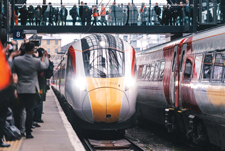|
On 18 March 2016, Virgin Trains introduced the first of its
new trains in a ceremony at King’s Cross Station in London. The new trains,
which are manufactured by Hitachi Rail at its rail vehicle manufacturing
facility in Newton Aycliffe, are called Azuma, the Japanese word for “east”. 65
trains provide 12,200 additional seats for a new and expanded timetable, which
will allow the Virgin Azuma trains to funnel 28% of increased passenger
capacity into King’s Cross during hours of peak operation.
 Secretary of State for Transport Patrick McLoughlin said, “The
state-of-the-art Intercity Express trains being supplied to Virgin Trains will
transform rail travel for passengers between London, the northeast, and
Scotland. These new trains, combined with Virgin’s exciting plans for the
franchise, will provide more services, more seats, and faster journeys, helping
to place passengers at the heart of the railway.” Secretary of State for Transport Patrick McLoughlin said, “The
state-of-the-art Intercity Express trains being supplied to Virgin Trains will
transform rail travel for passengers between London, the northeast, and
Scotland. These new trains, combined with Virgin’s exciting plans for the
franchise, will provide more services, more seats, and faster journeys, helping
to place passengers at the heart of the railway.”
Sir Richard Branson, founder of the Virgin Group, said, “This
is a hugely important moment for passengers on the East Coast. A line which has
witnessed the historic Flying Scotsman and Mallard trains will now see
passenger services transformed with the UK’s most advanced long-distance
trains. Our customers on the West Coast have already seen what Virgin can bring
to train travel and how the Pendolinos have made a huge difference to speed and
comfort. Our new fleet of Azumas will bring a similar transformation to the
East Coast and propel one of the UK’s most prestigious lines into the 21st
century.”
While fundamental train speeds will reach up to 125 mph,
Virgin Trains announced on the same day the creation of a cross-industry
working group, including Network Rail, that will examine possibilities for the
east coast route to operate at 140 mph. The new trains will include highly serviceable
features, such as fast acceleration, fast journeys, generous space for leg room
and comfort, produce lowe emissions, fast and free Wi-Fi and a sophisticated seat-reservation
system.
Full article: IEEE Vehicular Technology Magazine, Volume 11, Number 3, September 2016 |